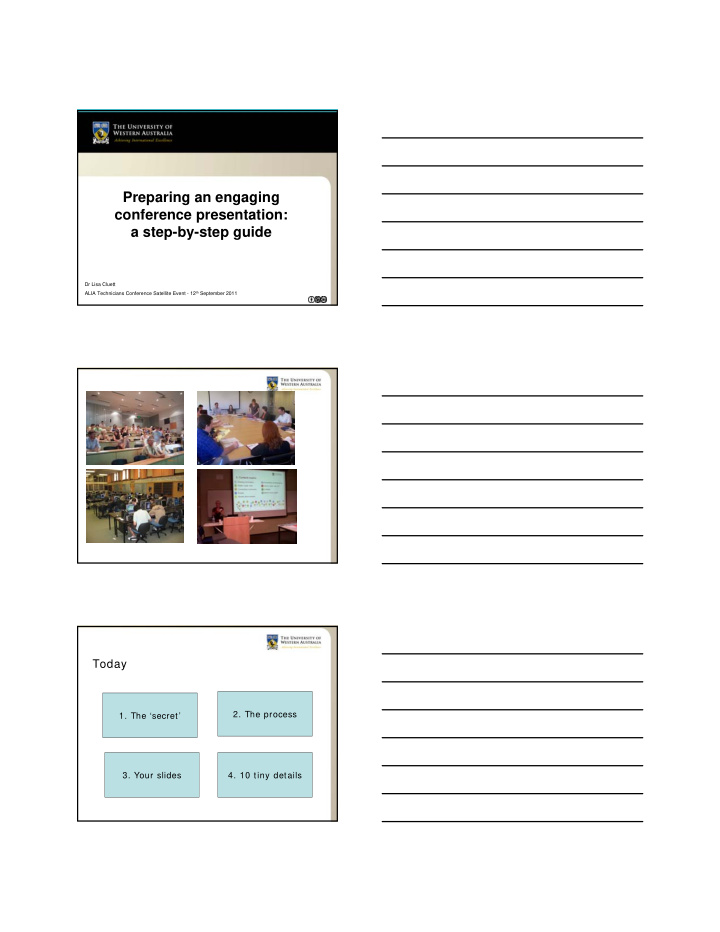



Preparing an engaging conference presentation: a step-by-step guide Dr Lisa Cluett ALIA Technicians Conference Satellite Event - 12 th September 2011 Today 2. The process 1. The ‘secret’ 3. Your slides 4. 10 tiny details
1. Before you start 1. The ‘ secret ’ Answer these two questions 1. What do you have that the audience wants? 2. What is your talk going to do ? (know the difference between talks that are about something and talks that do something) Activity (2-parter) • Think of a talk you are doing soon or have done recently • What is it you have • Based on what you that your audience have – what is your want? talk going to do? (what do you ‘have’ that (should see verbs here!) they need? could • What will your talk not use?) do? • Write it down. • Write it down.
2. step-by-step process Preparation Make your ‘purpose’ the beginning and the end 1. Create sub-sections (on paper) 2. Write points for each slide (not content) 3. Open 1 slide per minute (to a max of 20 mins) 4. ‘flesh out’ PowerPoint last 5. Example What I ‘have’ – a new way of training staff in IT My purpose – to convince you that it’s easy and effective Time – 15 minutes Opening Why How Issues Close 1. title 3. 6. 10. 13. purpose 2. purpose 4. 7. 11. 14. More info 5. 8. 12. 9.
Structure – a strong start think of an opening line that is: not your name or seminar title not a ‘thanks for coming’ makes your seminar stand out (in a good way) engaging to the audience related to your key message 3. ‘visuals’ Good practice Readable + Relevant + Interesting + Supportive
• Topic sentence – introduces the paragraph topic in the context of the overall argument or purpose of the essay: It is important to examine each element of the Wilkinson v Downton action in order to see how the tort has become unnecessary in the wake of the ever expanding tort of negligence. • Examines key elements in the Wilkinson case in the light of Hoffmann’s contention that it has been made redundant by the principles of negligence: Firstly, there must be a act “wilfully done”… Wilful in this context suggests … voluntariness… an “essential feature of all torts” … i.e. indistinguishable from the requirements of negligence etc. • Does not spend too much time or space describing or restating cases but rather highlights those elements that are relevant to the purpose of the essay: Downton did not intend to cause physical harm… “calculated” cannot therefore be limited to subjective intention… denotes an objective standard of conduct akin to… the tort of negligence • Signposts the flow of his examination / arguments by using linking or connective words and phrases: Firstly…, however…, arguably…, therefore… • Use expert sources (primary and secondary) to support the points / arguments he is making: McPherson JA in Carrier v Bonham identifies the problem as being … (He uses both quotation and paraphrase) • He draws together his examination / argument to a clear and focussed conclusion which supports the thesis statement: …any wrongful act that satisfies the stricter test in Wilkinson v Downton will also satisfy the ordinary principles of negligence, therefore making the need for a separate tort non-existent. The Online Student Journey welcomes events tours graduation housing admin workshops loans mentoring enrolments training newsletters study groups advice orientations enquiries offers records fees networking Online delivery and interactivity
Training program ‘Multi-channel’ options Awareness raising in person • Demonstration of toolbox • Focus on content • Team training sessions • Individual follow-up • Stand alone resources (info sheets, instructions, video etc) X General ‘information’ sessions What questions do staff ask? Is it accessible? Alternative access options Is it free? Clearly outline subscription Is it legal? Clarify policies and disclaimers Is it difficult? Set up a rating scale Suggest maintenance needs Will it look after itself? Time the testers How long does it take? Issues Issues for institutions Cultural implications Social and generational issues Socio-political concerns Issues for ICT designers Maintenance – staff time and skills required Relevance – keeping content useful and timely Issues for users Accessibility – text transcripts, info on file size Interaction – subscription, posting questions, blog, folksonomy
Potential outcomes Collaborate with existing projects • MyUWA, iPoint, Raiser’s Edge, UniLink, NODE, Lectopia/iTunesU etc Initiate and integrate new tools • (e.g.) Facebook, vokis/Sitepal, Google maps, Flickr, votapedia, Second Life Virtual one stop shop? Targeted messages to student cohorts (via SMS, RSS, Facebook?) Animated characters as campus guides, student advisors, peers etc 4. 10 tiny details 1. stay on time 6. engage; don’t read 2. be in charge 7. use graphics 3. be sincere 8. use ‘sign-posts’ 4. practice needs 9. simplify with feedback confidence! 5. visit the venue 10.take ‘papers’ Feedback
Recommend
More recommend